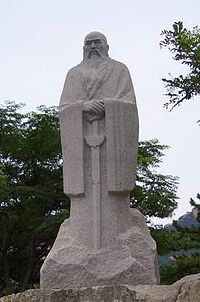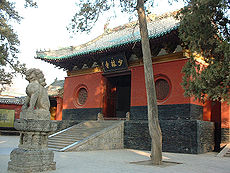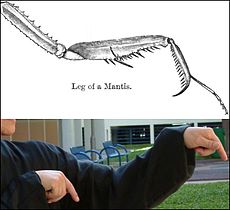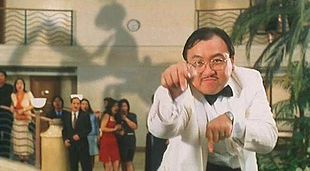- Northern Praying Mantis (martial art)
-
For the Southern Chinese self-defence technique of the Hakka people, see Southern Praying Mantis (martial art).
Tang Lang
Stone monument to Wang Lang on Laoshan in Shandong Province.Also known as Tong4 Long4
Tōrō-kenFocus Striking Country of origin  China
ChinaCreator Wang Lang (王朗) Part of the series on
Chinese martial artsList of Chinese martial arts Terms Historical places - Shaolin Monastery (少林寺)
- Wudang Mountains (武當山)
- Mount Hua (華山)
- Mount Emei (峨嵋山)
- Kunlun Mountains (崑崙山)
Historical people - Five Elders (五祖)
- Yim Wing-chun / Yan Yongchun (嚴詠春)
- Hung Hei-gun / Hong Xiguan (洪熙官)
- Fong Sai-yuk / Fang Shiyu (方世玉)
- Dong Haichuan (董海川)
- Yang Lu-ch'an (楊露禪)
- Wu Quanyou (吳全佑)
- Ten Tigers of Canton (廣東十虎)
- Chen Fake (陳發科)
- Chan Heung / Chen Xiang (陳享)
- Wong Fei-hung / Huang Feihong (黃飛鴻)
- Sun Lu-t'ang (孫祿堂)
- Huo Yuanjia (霍元甲)
- Yip Man / Ye Wen (葉問)
- Wang Zi-Ping (王子平)
- Bruce Lee / Li Xiaolong (李小龍)
- Jackie Chan / Cheng Long (成龍)
- Sammo Hung / Hong Jinbao (洪金寶)
- Yuen Biao / Yuán Biāo (元彪)
- Jet Li / Li Lian Jie (李連杰)
- Donnie Yen / Zhēn Zǐdān (甄子丹)
Legendary figures - Bodhidharma / Putidamo / Damo (菩提達摩)
- Zhang Sanfeng (張三丰)
- Eight immortals (八仙)
Related Northern Praying Mantis (Chinese: 螳螂拳; pinyin: tánglángquán; literally "praying mantis fist") is a style of Chinese martial arts, sometimes called Shandong Praying Mantis after its province of origin. It was created by Wang Lang (王朗) and was named after the praying mantis, an insect, the aggressiveness of which inspired the style. One Mantis legend places the creation of the style in the Song Dynasty when Wang Lang was supposedly one of 18 masters gathered by the Abbot Fu Ju (福居), a legendary persona of the historical Abbot Fu Yu (福裕) (1203–1275), to improve Shaolin martial arts.[1] However, most legends place Wang Lang in the late Ming Dynasty.[2][3]
Contents
Features
The mantis is a long and narrow predatory insect. While heavily armoured, it is not built to withstand forces from perpendicular directions. Consequently, its fighting style involves the use of whip-like/circular motions to deflect direct attacks, which it follows up with precise attacks to the opponent's vital spots. These traits have been subsumed into the Northern Praying Mantis style, under the rubric of "removing something" (blocking to create a gap) and "adding something" (rapid attack).[4]
One of the most distinctive features of Northern Praying Mantis is the "praying mantis hook" (螳螂勾; pinyin: tángláng gōu): a hook made of one to three fingers directing force in a whip-like manner. The hook may be used to divert force (blocking), adhere to an opponent's limb, or attack critical spots (eyes or acupuncture points). These techniques are particularly useful in combination, for example using the force imparted from a block to power an attack. So if the enemy punches with the right hand, a Northern Praying Mantis practitioner might hook outwards with the left hand (shifting the body to the left) and use the turning force to attack the enemy's neck with a right hook. Alternately, he/she might divert downwards with the left hook and rebound with the left wrist stump to jaw/nose/throat.
Northern Praying Mantis is especially known for its speed and continuous attacks. Wrist/arm techniques in particular are emphasized, as well as knee and elbow strikes. Another prominent feature of the style is its complex footwork, borrowed from Monkey Kung Fu.
Origins
There are many legends surrounding the creation of Northern Praying Mantis boxing. One legend attributes the creation of Mantis fist to the Song Dynasty when Abbot Fu Ju (福居), a legendary persona of the historical Abbot Fu Yu (福裕) (1203–1275), supposedly invited Wang Lang (王朗) and seventeen other masters to come and improve the martial arts of Shaolin.[5] The Abbot recorded all of the techniques in a manual called the Mishou (祕手 – "Secret Hands") and later passed it onto the Taoist priest Shen Xiao. This manual supposedly disappeared until the Qianlong reign era when it was published under the name "Arhat exercising merit short strike illustrated manuscript" (Chinese: 罗汉行功短打; pinyin: Luóhàn Xínggōng Duǎn Dǎ).[5] Some sources place the folk manuscript's publication on the "sixteenth day of the third month of the spring of 1794".[6] The manual records Wang Lang "absorbed and equalized all previous techniques" learned from the 17 other masters.[2][6]
The 18 Masters Invited to Shaolin # Name Technique Master 1 Changquan Long-range Boxing Emperor Taizu 2 Tongbeiquan Through the Back Han Tong 3 Chan Feng Wrap Around and Seal Zhang En 4 Duanda Close-range Strikes Ma Ji 5 Keshou Tongquan Blocking Hands and Following Through Fist Jin Xiang 6 Gou Lou Cai Shou Hooking, Scooping and Grabbing Hands Liu Xing 7 Zhanna Diefa Methods of Sticking, Grabbing, and Falling Yan Qing 8 Duan Quan Short Boxing Wen Yuan 9 Hou Quan Monkey Boxing Sun Heng 10 Mien Quan Cotton Fist Mien Shen 11 Shuailue Yingbeng Throwing-Grabbing and Hard Crashing Huai De 12 Gunlou Guaner Ducking, Leaking and Passing through the Ears Tan Fang 13 Chuojiao Mandarin ducks kicking technique Lin Chong 14 Qishi Lianquan Seven Postures of Continuous Fist Strikes Meng Su 15 Kunlu Zhenru Hand Binding and Grabbing Yang Gun 16 Woli Paochui Explosive Strikes into the Hollow Body Parts Cui Lian 17 Kao Shou Close Range Hand Techniques Huang You 18 Tanglang Praying Mantis Wang Lang
A third of the masters listed all come from fictional novels. Yan Qing (#7) and Lin Chong (#13) come from the Water Margin and Emperor Taizu (#1), Han Tong (#2), Zhang En (#3) and Huai De (#11) come from the Fei Long Quan Zhuan (飞龙全传 – “The Complete Flying Dragon Biography”), which was published prior to the aforementioned manual.[7]Another legend connected to the Song Dynasty states Wang Lang participated in a Lei tai contest in the capital city of Kaifeng and was defeated by General Han Tong (韩通), the founder of Tongbeiquan. After leaving the fighting arena, he saw a brave praying mantis attacking the wheels of oncoming carts with its "broadsword-like" arms, Mantis fist was born shortly thereafter.[8] However, most legends place Wang Lang living in the late Ming Dynasty.[2][3]
Connection with General Yue Fei
 The "Four Generals of Zhongxing" painted by Liu Songnian during the Southern Song Dynasty. Yue Fei is the second person from the left. It is believed to be the "truest portrait of Yue in all extant materials."[9]
The "Four Generals of Zhongxing" painted by Liu Songnian during the Southern Song Dynasty. Yue Fei is the second person from the left. It is believed to be the "truest portrait of Yue in all extant materials."[9]
As previously stated, the Water Margin bandits Lin Chong and Yan Qing, the adopted of Lu Junyi, are said to be part of the 18 masters supposedly invited to Shaolin by the legendary Abbot Fuju. According to the folklore biography of Song Dynasty General Yue Fei, Lin and Lu were former students of Zhou Tong, the general’s military arts teacher.[10] One martial legend states Zhou learned Chuojiao boxing from its originator Deng Liang (邓良) and then passed it onto Yue Fei.[11] Chuojiao is also known as the "Water Margin Outlaw style" and "Mandarin Duck Leg" (Chinese: 鴛鴦腿; pinyin: Yuānyāng Tuǐ).[12] In the Water Margin's twenty-ninth chapter, entitled "Wu Song, Drunk, Beats Jiang the Gate Guard Giant", it mentions Wu Song, another of Zhou's fictional students, using the "Jade Circle-Steps with Duck and Drake feet".[13] Lin Chong is listed above as being a master of "Mandarin ducks kicking technique".
Lineage Mantis Master Yuen Man Kai openly claims Zhou taught Lin and Lu the "same school" of martial arts that was later combined with the aforementioned seventeen other schools to create Mantis fist.[14] However, he believes Mantis fist was created during the Ming Dynasty, and was therefore influenced by these eighteen schools from the Song. He also says Lu Junyi taught Yan Qing the same martial arts as he learned from Zhou.[15] Master Yuen further comments Zhou later taught Yue the same school and that Yue was the originator of the mantis move "Black Tiger Steeling [sic] Heart".[15] Note that the various branches of Yue Jia Quan (Yue Family Boxing) do indeed have an analogous postural movement named "Black Tiger Steals the Heart". Also various Yue Jia Quan sets feature a "Preying Mantis Pounces on Prey" claw hand posture as well.
Styles
Widespread styles
There are several styles of Northern Praying Mantis, the best known of which are:
- Seven Star Praying Mantis Boxing (Chinese: 七星螳螂拳; pinyin: qī xīng tángláng quán). This style is the original form of praying mantis kung fu and is widespread in the Shandong Province and surrounding areas. Luo Guangyu (羅光玉) is known for having passed down this style to Hong Kong and other parts of Southern China, where it is still practiced today. Seven Star is considered by many as the 'hardest' of the Praying Mantis styles, however it still utilizes soft-hard principles and is classified as a soft-hard style.
- Plum Blossom Praying Mantis Boxing (Chinese: 梅花螳螂拳; pinyin: méihuā tángláng quán). One of the oldest among all Northern Praying Mantis styles, it is widespread in Shandong Province, Jilin, Liaoning and South Korea. It traces its lineage directly from Li Bingxiao (b.1700s) to Zhao Zhu to Liang Xuexiang (1810–1895). Liang Xuexiang was the first master to use the name of Plum Blossom. Liang Xuexiang's disciples, mainly Jiang Hualong, Liang Jingchuan, Sun Yuanchang, Hao Hong and Xiu Kunshan are responsible for popularization of this style in the 20th century. In the early 1900s, it heavily influenced the development of Taiji Mantis of Cui Shoushan and Wang Yushan, Taiji Plum Blossom of Hao Family, Taiji Mantis of Zhao Zhuxi and Babu Mantis of Wei Xiaotang.
- Taiji Praying Mantis Boxing (Chinese: 太極螳螂拳; pinyin: tàijí tángláng quán). Today this style is represented by two distinct lineages. The first one is that of Cui Shoushan and Wang Yushan and is based on Song Zide and Jiang Hualong's Plum Blossom teachings in Laiyang, Shandong Province. It is popular in Laiyang, Yantai, Qingdao, Dalian, North America, Russia, France and Spain. The second lineage can be traced to Sun Yuanchang's Blum Blossom, who was yet another disciple of Liang Xuexiang. Its best known progenitor is Zhao Zhu Xi, who is said to have taught (both directly and indirectly) thousands of students during his lifetime in Vietnam and Hong Kong, who have since spread to all corners of the globe. He was given the Cantonese nickname Chuk Kai, meaning "Bamboo Creek", for a famous battle he fought with bandits at that location. This style has since become prevalent in places such as Korea, Hong Kong, Vietnam, and North America.
- Taiji Plum Blossom Praying Mantis Boxing (Chinese: 太極梅花螳螂拳; pinyin: tàijí méihuā tángláng quán). This style is, historically, a combination of two different lineages of Mantis: Taiji Mantis and Plum Blossom Mantis. This style is widespread in Yantai, Qingdao, Beijing, Dalian, Harbin, etc. What is now called Taiji Plum Blossom traces its lineage to Hao Lianru (郝蓮茹)—a disciple of Liang Xuexiang, his sons Hao Henglu, Hao Hengxin and his grandson Hao Bin. The later three combined both Taiji Mantis and Plum Blossom in the early 20th Century, creating the current style. Hao Lianru's five sons have since spread the style elsewhere. This style is well-known for its large, two-handed sword, and for being somewhat 'softer' than Seven Star Praying Mantis.
- Six Harmony Praying Mantis Boxing (Chinese: 六合螳螂拳; pinyin: liù hé tángláng quán). Known as the 'softest' or most 'internal' of the Praying Mantis styles, Six Harmony was passed down by Ding Zicheng (丁子成), whose students taught in Shandong Province as well as Taiwan. Six Harmony Praying Mantis has a very different curriculum, with unique routines not found in other Praying Mantis styles.
- Eight Step Praying Mantis Boxing (Chinese: 八步螳螂拳; pinyin: bā bù tángláng quán). This style was originally conceived by Jiang Hua Long, and was further refined by his principle disciple of the style, Feng Huanyi (馮環義), which was passed down by his disciple Wei Xiaotang (衛笑堂) in Taiwan. Which was passed down to his disciple Shyun Guang Long.
Rare styles
Other, less widespread styles include:
- Shiny Board Praying Mantis Boxing (Chinese: 光板螳螂拳; pinyin: guāng bǎn tángláng quán). Also known as "flat plate" or "hidden grip" Praying Mantis.
- Long Fist Praying Mantis Boxing (Chinese: 長拳螳螂拳; pinyin: cháng quán tángláng quán). Influenced strongly by Long Fist boxing.
- Throwing Hand Praying Mantis Boxing (Chinese: 摔手梅花螳螂拳; pinyin: shuāishǒu méihuā tángláng quán). This style was passed down by Bao Guangying from Shandong Province. He taught in Hong Kong and Guangzhou.
- Secret Gate Praying Mantis Boxing (Chinese: 秘門螳螂拳; pinyin: mì mén tángláng quán). This style was passed down by Zhang Dekui (張德奎) in Taiwan and is a variation of Taiji Mantis.
Media
Mantis fist is usually the main antagonist's style of choice in various forms of media.
Film
In The Tricky Master (1999), Stephen Chow's apprentice beats an overweight card sharp in a "fixed" high-stakes poker game. When taunted, the card sharp jumps onto the playing table and defeats Chow's deaf, cross-dressing bodyguard with a "long lost kung fu" called "Fat Mantis", which is the "most powerful...and kills without blood." (Note the card sharp’s shadow cast upon the wall in the shape of an overweight mantis with a big round belly.) In the end, Stephen Chow sprays the card sharp with a can of insecticide. He falls to the ground dead with his hands and legs held into the air like a bug.
In The Forbidden Kingdom (2008), the "Silent Monk" (Jet Li) employs mantis fist in his battle over the Monkey King's magical staff with Lu Yan, the "Drunken Immortal" (Jackie Chan). But his Mantis boxing is shortly thereafter overpowered by Lu's Tiger boxing. The movie's screenwriter, John Fusco, is a long-time student of Northern Praying Mantis and worked closely with Jet Li during production.
In the animated movie Kung Fu Panda, one of the six kung fu students is an actual praying mantis who uses Northern Praying Mantis kung fu.[16]
Television
In Hung Hei-Gun: Decisive Battle With Praying Mantis Fists (洪熙官: 决战螳螂拳) (a.k.a. The Kung Fu Master, 1994), Donnie Yen plays the titular role of legendary martial arts hero Hung Hei-Gun. After being beaten up as a Child, Hung's parents send him away to study Kung Fu. He returns eight years later to find his father (who is secretly an anti-Manchu rebel leader) working as the military arms instructor for the Qing government, much to the chagrin of the local villagers. Despite his years of training, a rakish manchu Prince easily overpowers Hung with the mantis style. After the supposed death of his father, Hung faces the prince once more. When the prince shoots poisonous arrows from his sleeves, Hung twirls his staff to collect the projectiles and then flings them back. The Prince dies from his own poison arrows.[17]
On the Nickelodeon show Avatar: The Last Airbender, a character named Toph Bei Fong practices earthbending differently than other characters. While the creators of the show and martial arts supervisor stated most earthbending is inspired by Hung Gar/ Tiger crane Kung Fu, Toph, being blind uses earthbending in a different way, waiting and listening before striking critical points of an opponents defense. Toph's style is inspired by Hakka style Southern and Northern praying mantis, she even uses the mantis hook hand pose several times. Her role in the show is quite vital, and her unique assets get praised several times by others in her group.
Books
Mantis is about a half-Vietnamese serial killer who murders erotic dancers because he believes his pet praying mantis tells him to do so (which is quite similar the real life case involving the "Son of Sam"). He uses this style of fighting utilizing his fingers to attack the neck veins and the eyes.[18]
Video games
Lion Rafale, a character from Sega's Virtua Fighter series, uses Praying Mantis style. He was introduced in Virtua Fighter 2. It is also used by Kung Lao and Shujinko in the Mortal Kombat series. Wulong Goth, the leader of the evil "Black Mantis" sect, employs Praying Mantis in the game Tao Feng: Fist of the Lotus. Gen, from the Street Fighter series of video games, uses this technique, which he can change at will with the Crane style. In the Eternal Champions series, Praying Mantis is used by Larcen Tyler.
References
Notes
- ^ Kohn, Livia. Daoism Handbook. Leiden: Brill, 2000. (ISBN 9004112081)
- ^ a b c Praying Mantis History, Lineage, and Styles
- ^ a b More Praying Mantis History
- ^ "Northern Mantis Barrage Training!". Inside Kung Fu. http://www.insidekung-fu.com/content/view/131/0/. Retrieved 2009-12-29.
- ^ a b (2001). Luohan Xinggong Duan Da. JOURNAL OF SPORT HISTORY AND CULTURE (体育文史), No.1, P.36-37,9 [ISSN 1671-1572]
- ^ a b What's Praying Mantis Kung Fu?
- ^ Wu, Xuan. Fei Long Quan Zhuan (飞龙全传). Changchun Shi: Jilin wen shi chu ban she, 1998 (ISBN 780626258X) (See here)
- ^ (Spanish)(English) SHANDONG WUSHU TAIJI TANGLANG QUAN
- ^ Shao Xiaoyi. "Yue Fei's facelift sparks debate". China Daily. Archived from the original on 2007-09-29. http://web.archive.org/web/20070929194758/http://zjxz.gov.cn/gb/node2/node138665/node139012/node139015/userobject15ai2978830.html. Retrieved 2007-08-09.
- ^ Qian, Cai. General Yue Fei. Trans. Honorable Sir T.L. Yang. Joint Publishing (H.K.) Co., Ltd. (1995) ISBN 978-962-04-1279-0
- ^ Chuo Jiao Fist
- ^ Chuojiao (thrusted-in feet)
- ^ Shi, Nai’an and Luo Guanzhong. Outlaws of the Marsh. Trans. Sidney Shapiro. Beijing: Foreign Language Press, 1993 (ISBN 7-119-01662-8)
- ^ Yuen, Man Kai. Northern Mantis Black Tiger Intersectional Boxing. Wanchai, Hong Kong: Yih Mei Book Co. Ltd., 1991 (ISBN 962-325-195-5), pg. 7.
- ^ a b Yuen: pg. 8
- ^ "KUNG FU PANDA: Big Bear Cat was "PO-fect"". Kung Fu Magazine. http://ezine.kungfumagazine.com/ezine/article.php?article=771. Retrieved 2009-12-28.
- ^ The Kung Fu Master movie review
- ^ La Plante, Richard. Mantis. Tor Books, 1993 (ISBN 0312855311)
Sources
- Profatilov, Ilya “The traditional history of Plum Blossom Praying Mantis boxing ”Journal of Martial Arts, Volume 10 Number 4.
- Taiping Martial Arts - Methodologies of Praying Mantis Kung Fu.
- Ilya Profatilov. History of Praying Mantis Kungfu.
- Eight Step. History of Eight Step Praying Mantis Kung Fu.
- Mantis Boxing Demonstration San Diego Mantis Boxing.
Chinese martial arts Styles Techniques Practical striking Practical grappling Wushu taolu (forms) Martial arts Regional origin Unarmed Weapons Training Grappling Folk wrestling · Brazilian Jiu-Jitsu · Catch Wrestling · Judo · Lucha Libre · Shoot wrestling · Greco-Roman wrestling · Freestyle wrestling · JujutsuFull contact sports Bare-knuckle boxing · Boxing · Full contact karate · Kickboxing · Mixed martial arts · Muay Thai · Sanshou · Shooto · Sambo · TaekwondoSelf-defense/Combatives Entertainment Categories:- Praying Mantis (wushu)
- Chinese martial arts
Wikimedia Foundation. 2010.




